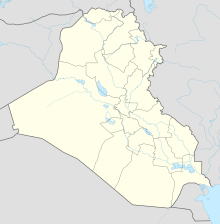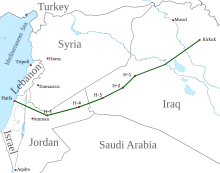H-3 (airfield)
Coordinates: 32 ° 55 ′ 46 ″ N , 39 ° 44 ′ 38 ″ E
The H-3 airfield was a large-scale Iraqi air force base in the desert area of al-Anbar Province . The military base is around 58 km west of the city of ar-Rutba near the Jordanian border.
Originally there was a pumping station on the Mosul-Haifa pipeline at H-3 , which was to be supplied via the airfield. Over time, the airfield was expanded to include two more runways (southwest and northwest), Hardened Aircraft Shelters and underground facilities.
Military importance and chemical weapons
The first military attack on H-3 took place on June 6, 1967 by the Israeli Air Force in the Six Day War . During the First Gulf War , H-3 was attacked by the Iranian Air Force on April 4, 1981 , as Saddam Hussein had positioned his strategic bombers on H-3.
Right at the start of the Second Gulf War on January 17, 1991, the H-3 was attacked by the US Air Force . The assumption that chemical weapons were stored or produced in the building complexes of H-3 could be verified by UNMOVIC . H-3 included a pilot plant that had produced the sarin precursors DMMP and MPF with a capacity of up to 500 kg per day between 1985 and 1987 . In 1988 and 1990, MPF, sarin and cyclosarin were produced there. Furthermore, chemical bombs of the type R-400 were found on H-3 NW + SW, on the H-3 mainbase additional 250 and 500 kg bombs with chemical content.
The Operation Desert Fox in December 1998 was also the H-3 complex as a target. Even before the Iraq war , H-3 was the target of air strikes in September 2002 to carry out the no-fly zone south of the 33rd parallel over Iraq. From March 20, 2003, the H-3 was the target of airborne operations by the Special Forces as part of the Iraq war, British and Australian special forces landed on H-3. Today the H-3 airfield is still used for charter flights.
See also
- H-2 (airfield) ( location H-2 )
![]() Map with all coordinates: OSM | WikiMap
Map with all coordinates: OSM | WikiMap
Remarks
- ↑ In 1984 Iraq feared an Israeli pre-emptive strike on the chemical plant similar to Operation Opera . Israel is said to have been warned of this through an intervention in Washington. The fact that no Israeli attack took place shows the influence Iraq had in the United States. → See Dilip Hiro: The Longest War. The Iran-Iraq Military Conflict. Routledge Chapman & Hall, New York 1991, ISBN 0-415-90407-2 , p. 118.
Individual evidence
- ↑ see Mosul – Haifa oil pipeline
- ↑ Location of the runway southwest
- ↑ Location of the runway northwest
- ^ Final report of the UN. (PDF; 13.6 MB) The Chemical Weapons Program , accessed January 14, 2013
- ↑ globalsecurity.org H-3, accessed January 2, 2013
- ↑ aviation-news.co.uk ( Memento June 24, 2013 in the Internet Archive ) Iraq's vanishing Air Force, accessed January 2, 2013
- ↑ stern.de ( Flash ; 26 kB) accessed on January 2, 2013
- ↑ eliteukforces.info accessed on January 2, 2013
- ↑ privatejetscharter.net accessed on January 2, 2013


